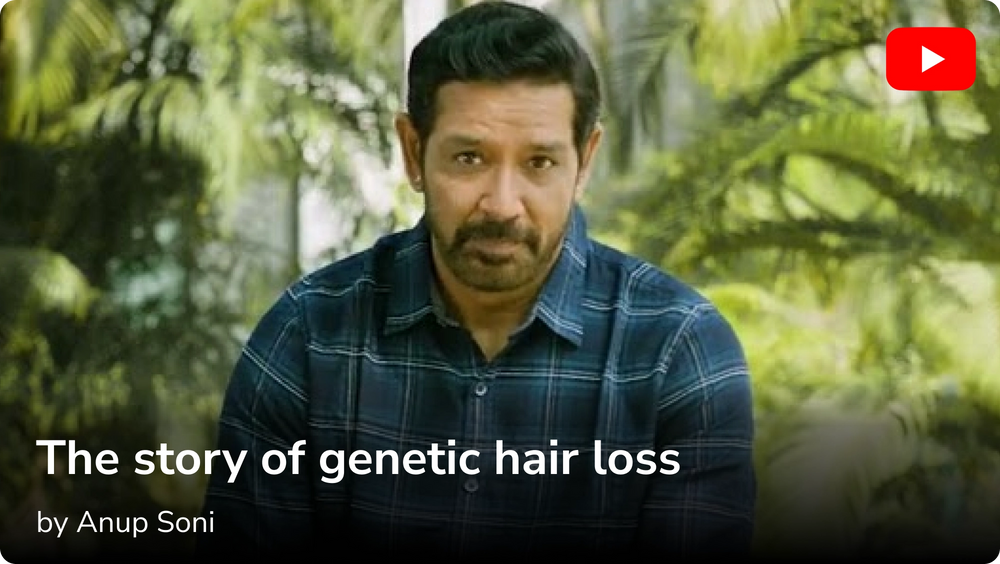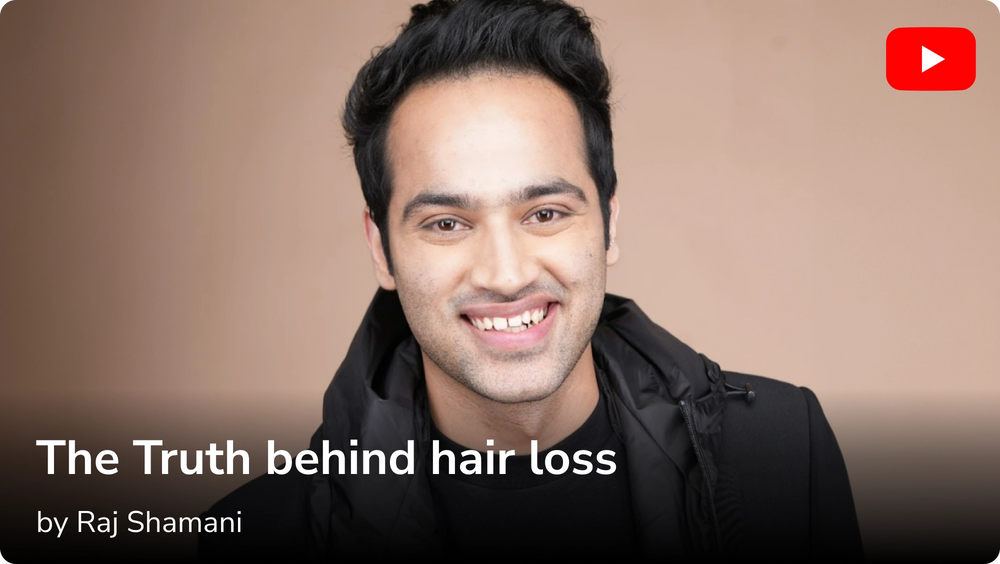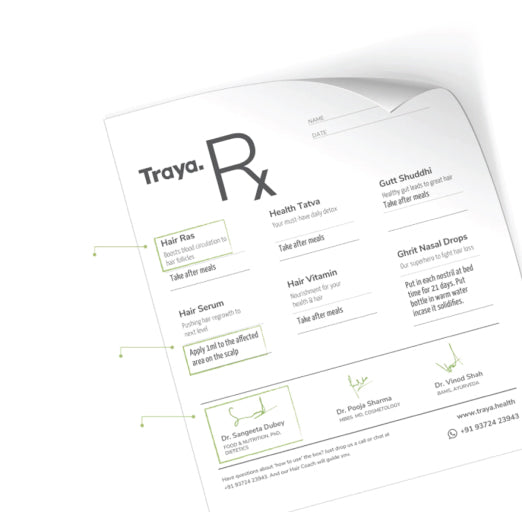In today’s fast-paced environment, hair damage is often gradual and goes unnoticed until it becomes a visible concern. Pollution, stress, irregular sleep, and harsh water quality all compound the problem. A well-structured hair care routine not only helps in restoring damaged hair but also strengthens it to withstand daily stressors. Think of it as preventive maintenance for your hair, just like skincare or fitness routines.
What is a hair care routine for hair growth?
A hair care routine is not just about external care. It's an integrated approach involving proper scalp hygiene, nourishing treatments, and lifestyle improvements that work together to stimulate hair growth. An effective routine should also include mindful habits such as avoiding tight hairstyles, limiting chemical treatments, and ensuring adequate rest. When you treat your hair like an extension of your overall health, visible improvements follow naturally.
Essential steps of a hair care routine
-
Scalp care: taking care of scalp needs is a must if you want your hair to grow. Natural hair oils like coconut oil, argan oil, avocado oil, almond oil can be used for massaging the scalp. Regular massaging helps in enhancing blood circulation and nourishing the cuticle by strengthening the roots. Apply these oils using your fingers and massage them in circular motions for about 5 to 10 minutes daily, and see the difference yourself. A healthy scalp means healthy hair growth!
-
Regular cleansing: just like our skin, our hair also needs to stay clean all the time. It is recommended to use a gentle, mild shampoo on your scalp. If you have oily hair, you must cleanse your scalp and hair in every 2 to 3 days. Washing hair every day can turn out to be bad for some people, as, it can strip off the natural oils from the scalp.
-
Conditioning: one of the most important steps in hair care routine for women as well as men is conditioning. It is used to restore the lost shine and moisture. After shampooing, the hair tends to get a little dry and even frizzy (for people with dry hair), this is when conditioner comes to play. A conditioner helps in sealing moisture all over the hair strands, and also prevent split and damaged ends, dryness which makes hair manageable.
-
Deep conditioning treatments: treatments are carried out for specific concerns like dandruff, frizz, dryness etc. bond treatments work best for damaged or chemically treated hair, application of anti-dandruff products can help for people with flaky scalp. This step can enhance the effects of other hair care steps if used correctly. However, it is recommended to see a dermatologist before starting any such treatment. Many DIY techniques such as coconut oil or banana avocado hair masks can also be used weekly for treating dry, damaged hair.
- Moisturizing: sealing in the moisture that we get from all the above steps is much more crucial than it sounds. Daily use of lightweight serums and oils, like Traya’s shine serum can help in maintaining moisturized, well-balanced hair and also help in hair growth.
- Scalp exfoliation: Using a gentle scalp scrub once every two weeks removes dead skin cells and product build-up, ensuring follicles remain open and healthy.
- Protective drying: Swap vigorous towel drying for a microfiber towel or soft t-shirt to minimize breakage caused by friction.
- Scalp stimulation: Add a 2–3 minute daily massage using your fingertips or a wooden comb to improve blood flow to your roots.
- Avoiding over washing: Stick to washing 2–3 times a week unless your scalp is extremely oily, to preserve natural oils that support hair health.
- Consistent hydration: Use hydrating sprays or leave-in conditioners between washes to maintain moisture balance. Nutrition and supplements for hair
Nutrition and supplements for hair
- Iron-rich foods: Add foods like pomegranate, beetroot, and dates to support haemoglobin levels, which transport oxygen to hair follicles.
- Vitamin B-complex: Include whole grains and bananas in your diet to strengthen hair at the cellular level.
- Antioxidant boost: Berries, spinach, and green tea can protect follicles from oxidative stress, which accelerates hair thinning.
- Zinc-rich foods: Pumpkin seeds, chickpeas, and lentils support tissue growth and repair, vital for follicle health.
- Water intake: Hydrating consistently helps flush out toxins, supporting overall scalp health and promoting nutrient absorption.
Diet’s role in hair care
Diet plays a very significant role in maintenance healthy hair and promoting hair growth. Health of the hair is closely linked to the nutrients that we consume on a daily basis, as these elements support the hair follicles and improve overall scalp condition. Incorporating these nutrients into your everyday diet can help in supporting and enhancing hair health leading to stronger and healthier hair:
Protein:
Hair is primarily known to be made up of keratin, which is a type of protein. Therefore, including adequate quantities of food rich in protein in your diet is really important for hair strength as well as growth. Lean meats, eggs, beans, cottage cheese, seeds and nuts are some excellent sources of protein that can be consumed daily.
Vitamins:
Vitamins A and C are known as the main elements driving sebum production, which helps in keeping the hair well moisturized and making it manageable. Some examples of foods rich in these vitamins are carrots, sweet potatoes, papaya, guava, broccoli, kale and citrus fruits. Vitamin E, extensively found in nuts and seeds, also helps in providing support to hair by enhancing blood circulation in the scalp.
Biotin:
Biotin, a B-vitamin, is known to actively promote hair growth by facilitating the production of keratin and also improving hair’s strength and elasticity. Foods high in biotin include eggs, avocados, legumes, seeds, nuts and whole grains.
Omega-3 Fatty Acids:
omega-3 fatty acids are healthy fats, that are found in fishlike salmon and even in flaxseeds, they also help in nourishing the hair and preventing dryness. These healthy fats support scalp health and also reduce inflammation, maintaining overall hair vitality.
Iron and Zinc:
Iron is considered vital for transporting oxygen to hair follicles, and zinc plays an important role in repair. Deficiencies in these minerals can lead to hair loss and also, damaged hair. It is advised to incorporate foods rich in iron like spinach and lentils. Some foods that can help in beating zinc deficiency are fish, nuts, seeds, mushrooms, etc.
Hydration:
Staying hydrated is the most important step towards healthy hair. Drinking plenty of water ensures that your hair remains moisturized, hydrated and doesn’t get easily damaged while supporting overall bodily functions that contribute to hair growth.
Best supplements for hair growth
- Collagen:
Collagen supplements can provide essential amino acids that are important for maintaining a healthy hair structure. Collagen is also known to improve strength and elasticity and also enhance overall scalp health. Collagen supplements can cause side effects in people who are sensitive. Bloating, digestion problems and allergies are some of the commonly reported side effects. Hence, it is advised to consult an expert before starting this supplement.
- Vitamin D:
Vitamin D is an element that is very, very important for the health of hair follicles. Many studies have shown in the past that vitamin D deficiency is linked to hair loss conditions such as alopecia. Supplements that contain vitamin D can help in stimulating hair growth and improving hair density. It’s often recommended to choose a supplement with vitamin D3 for better absorption.
- Vitamin E:
Vitamin E is an antioxidant that helps stimulate blood circulation and protect hair follicles from environmental stressors like oxidative stress. This vitamin is known to support a healthy scalp, which is the epitome of hair growth. It also helps in reducing inflammation and repairing of damaged hair. Supplements containing vitamin E can be beneficial for people who have dry or brittle hair. Incorporating foods like almonds and spinach into your diet can bridge the gaps for better hair growth.
- Saw Palmetto:
Saw palmetto is a well -known herbal supplement that can help in addressing hair loss related to androgenic alopecia, both in females and males
It is also believed that it inhibits the conversion of testosterone into dihydrotestosterone (DHT), a hormone heavily linked to hair fall. This supplement is available in various forms, such as capsules and tablets. It can turn out to be a very useful option for people who are currently experiencing hair thinning or hair fall due to hormonal imbalances. As with any supplement, it is advised to consult with an expert before starting, especially if you have any underlying health issues.
- Marine collagen:
Sourced from fish, this is believed to be more bioavailable and supports faster tissue regeneration.
- Silica supplements:
Derived from bamboo or horsetail extract, silica strengthens hair shafts and promotes elasticity.
- Vitamin C:
Enhances iron absorption and supports collagen synthesis, improving scalp circulation.
- Evening primrose oil:
Rich in gamma-linolenic acid (GLA), it helps balance hormones and soothe scalp inflammation.
- Adaptogens:
Herbs like ashwagandha help the body manage stress, which is a hidden contributor to hair loss.
Common mistakes in hair care routine
Over washing of hair: washing your hair too much can bring unwanted hair loss issues. It is the most common mistake one can make while following a hair wash routine. It can cause the scalp to become dry by striping away the natural oils. Dryness, excessive hair fall, brittle and damaged hair are some problems that may arise by washing hair too much.
Usage of wrong products: using the wrong hair products is a significant hair care mistake that one can make. Products that do not suit your hair type can cause issues like dryness, breakage, and excessive oiliness. For example, using a heavy shampoo on fine hair can make it look weighed down, while a clarifying shampoo might dry out colored or chemically treated hair. It’s absolutely vital to select products formulated for your particular hair type and other requirements.
Ignoring scalp health: scalp health is the ground that can enhance new hair growth. Best hair care routines are those that begin with scalp care techniques. Massaging it and cleansing it regularly can stimulate blood circulation that is responsible for boosting new hair growth. Ignoring scalp health can affect the overall hair texture and make it dull.
Brushing wet hair: Wet hair is fragile. Use a wide-toothed comb starting from the ends to prevent breakage.
Skipping heat protection: Always use a heat protectant spray before blow-drying, straightening, or curling.
Neglecting seasonal care: Adjust your routine as per season. In monsoon, focus on anti-frizz care; in winter, increase hydration.
Tight hairstyles: Avoid consistently tying hair too tightly as it can cause traction alopecia over time.
Overusing dry shampoos: While convenient, excessive use can clog pores and reduce scalp health.
Also read: Hair growth Facts & Tips
DIY treatments for hair growth
Egg and olive oil hair mask: egg and olive oil hair mask is a nourishing treatment that can promote hair growth, and is also rich in proteins and fatty acids. To prepare this mask, mix one whole egg with two spoons of olive oil. The egg is a known source of proteins and biotin, which are important for strengthening hair, while olive oil moisturizes and smoothens the hair strands. Apply the mixture on damp hair, focusing on the roots as well as the lengths. Leave it on for about 20 to 30 minutes, then rinse thoroughly. This mask helps in improving hair elasticity, reduces breakage, and promotes new and healthy growth.
Avocado and honey hair mask: Avocado and honey are both excellent sources for moisturizing and repairing damaged hair, which in turn can help in hair growth. To prepare this mask, mash one avocado and mix it properly with two spoons of honey. Avocado is a rich source of vitamins A, D, and E, which nourish the scalp and promote hair growth, while honey is a known natural humectant, that can seal moisture into the hair. Leave this mask on for 30 to 40 minutes before rinsing hair with lukewarm water. This mask deeply conditions the hair, making it silkier and manageable while promoting new hair growth.
Onion juice hair mask: Onion juice is a hair fall remedy that gained popularity a few years back. It is known for stimulation of hair growth due to high sulfur content, which improves blood circulation to the scalp and promotes healthy hair follicles growth. For preparing the hair mask, extract juice from one onion and apply it directly to the scalp using a cotton ball. Leave it on for 15 to 20 minutes, then rinse with a sulphate- free, mild shampoo. Regular use of this hair mask can help reduce hair fall and encourage new hair growth.
Fenugreek hair mask: Soak fenugreek seeds overnight, grind to a paste, and apply weekly to boost shine and stimulate roots.
Curry leaves infusion: Boil curry leaves in coconut oil, strain, and use as a pre-shampoo treatment to strengthen hair.
Rice water rinse: Rich in amino acids, rice water improves elasticity and strengthens hair strands.
Amla powder pack: Mix amla powder with yogurt for a vitamin C-rich mask that strengthens roots.
Green tea spray: Cool brewed green tea and spritz it onto the scalp for its antioxidant benefits.
Protective hair styles and techniques
Hair styles that minimize breakage: Protective hairstyles are known to protect the hair from any kind of damage and also minimizes breakage. Styles like loose braids, twists, buns, and updos help to reduce breakage and split ends. Protective hair styles can also help in reducing stress on hair follicles and also minimizing pulling. Avoid tight hairstyles that cause tension on the scalp, as they can lead to hair loss over time.
Night time hair care routine: Night time care for hair is an extremely important step for maintaining healthy hair as well as for preventing breakage. For protection of your hair while sleeping, using a silk or satin pillowcase can help in reduce breakage and also smoothens hair naturally. Fabrics like cotton, on the other hand, cause friction that might lead to breakage. Alternatively, you can also wrap your hair in a silk or satin bonnet. These fabrics can help in reducing friction and retain moisture. Applying a leave- in conditioner or light weight hair oil before going to bed can keep your hair well hydrated and reduce dryness. Avoid sleeping with wet hair at all costs, as it is more prone to breakage and hair fall.
Heat styling: Heat styling can turn out to be damaging if not done with proper care and techniques. For minimizing damage, it is advised to always use a heat protectant spray before using heat- based products. This creates a protective shield between your hair and the styling tools. Choose heat styling tools that have adjustable temperature settings and use the lowest heat level. Avoid using excessive heat and try to reduce styling.
Loose buns or braids: Help minimise friction while you sleep or during busy days.
Scarf protection: Use silk or satin scarves to protect hair from sun exposure and pollution when outdoors.
Alternate hairstyles: Rotate your hairstyles to avoid prolonged stress on the same hair sections.
Low-manipulation days: Give your hair rest days with minimal styling and manipulation.
Moisturise before protective styles: Always apply a leave-in conditioner before braiding or twisting hair to retain moisture.
Understanding hair types and tailoring hair care routine
Understanding your hair type is the most important step for developing a hair care routine tailored to your specific needs. You can have straight, wavy, curly, or coily hair, each of which requires different care routines. For instance, straight hair mostly needs lightweight products to prevent it from weighing down, while curly or coily hair require using heavier moisturizers and leave-in conditioners or hair creams to maintain hydration and reduce frizz. Also, hair texture, that can range from fine to thick, impacts product selection and hair maintenance techniques. Fine hair needs volumizing shampoos and lightweight products to avoid buildup, and thick hair requires dense or heavy conditioners and detangling techniques to manage it effectively.
Understanding these distinctions can help anyone in customizing their best hair care routine. For instance, to maintain straight hair, one must focus on gentle cleansing along with light weight conditioners and oils to keep your hair smooth without overusing products. Wavy hair, on the other hand, benefits from products that smoothen and enhance hair texture without causing stiffness. Curly and coily hair types require deep conditioning and regular moisturization to maintain moisture retention and reduce breakage.
Developing your hair care routine begins with selecting the right products based on your hair's needs and concerns. Incorporating practices such as regular trimming and protection from excessive heat styling also plays a significant role in enhancing overall hair health.
- Straight hair: Use lightweight volumising products to avoid flatness and keep the scalp clarified.
- Wavy hair: Use curl-enhancing creams to define waves while keeping frizz under control.
- Curly hair: Incorporate deep conditioning masks weekly to maintain elasticity and reduce dryness.
- Coily hair: Prioritise heavy moisturisers and protective styling to lock in hydration and minimise breakage.
- High-porosity hair: Use protein treatments to fill gaps in the hair shaft and reduce porosity.
- Low-porosity hair: Apply products when hair is damp and use gentle heat (like warm towel wraps) to aid product absorption.
Advanced hair growth techniques
Microneedling: Also known as collagen induction therapy, microneedling is an advanced technique that uses a device with very, very fine needles to make micro injuries on the scalp. This whole process stimulates the body’s healing response to the injuries, increasing the production of collagen. These hair growth factors stimulate blood circulation and support the renumeration of hair follicles, which can improve hair density and reduce hair fall. Microneedling is often combined with effective topical treatments like minoxidil to enhance its efficacy.
Laser therapy: Laser therapy, or low-level laser therapy (LLLT), involves usage of red light to penetrate deep into the scalp and stimulate hair follicles. The light energy promotes enhanced cellular activity by increasing blood flow to the scalp, which in turn helps in healthy hair growth. Laser devices like laser combs, helmets, or even caps, are commonly used for this therapy. Regular treatments by an expert are essential to achieve as well as maintain results. This practice is generally considered safe by experts.
PRP treatments: Platelet-rich plasma or PRP therapy starts by drawing a small amount of your blood, processing it to concentrate the platelets, and then injecting the concentrated element into the scalp. The high concentration of growth factors in platelet rich plasma can help in rejuvenating hair follicles, enhancing hair growth, as well as hair density. This treatment is usually administered in a number of sessions, and is quite effective for various patterns of hair loss. This procedure has a low chance of causing any side effects and is considered usually safe for most people.
Scalp massages with essential oils: Adding rosemary or peppermint essential oils can boost circulation and enhance results.
Hair steaming: Use a handheld steamer or steam towel wrap post-oiling to open follicles and improve penetration of treatments.
Customized PRP plans: Work with trichologists to personalise the frequency and focus areas of PRP therapy for your hair needs.
Microneedling with serums: Pair microneedling with growth factor serums for enhanced absorption and accelerated results.
Low-level laser helmets: Safe for at-home use, these devices boost blood flow and follicular activity.
Conclusion
A thoughtful, consistent hair care routine is an investment that pays off over time. When you combine external care with internal nourishment and mindful practices, you not only improve hair growth but also enhance overall scalp health and confidence. The key lies in understanding your hair’s unique needs, staying patient, and giving your hair the care it deserves — every single day.
FAQs
How long does it take to see results after following a hair care routine?
This question is very subjective, as, different people have different needs, conditions that can determine the time required to see good results after following a hair care routine. For some people, it might take a few weeks and for some, this time might even go up to a year.
Can everyone achieve hair growth by following hair care routines?
For most people, following a hair routine developed according to their needs can promote hair growth. However, in some cases, finding the root cause of hair fall or no new hair growth is crucial.
Are natural hair products better for growth?
Yes, natural hair care products can promote hair growth by causing minimal damage to the scalp or hair. Most of these DIY ingredients are available readily in everyone’s kitchen.
Does changing pillowcases help with hair growth?
Yes, switching to silk or satin pillowcases reduces friction, preventing breakage and helping hair retain its moisture overnight.
How do hormones affect hair growth?
Hormonal imbalances, especially involving androgens or thyroid hormones, can disrupt the hair growth cycle and lead to shedding.
Can seasonal changes affect my hair care routine?
Absolutely. In winter, increase hydration; in summer, protect from UV rays and manage sweat-related scalp issues.




















